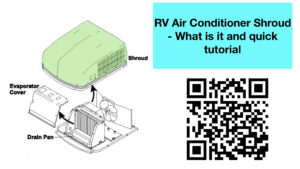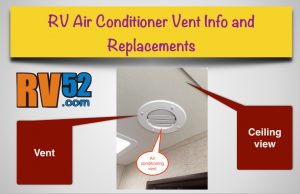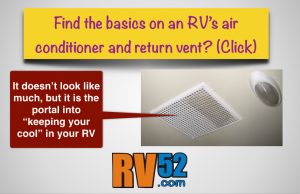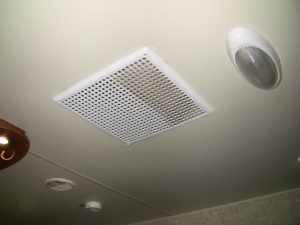RV AC Maintenance – How to find replacements, how to maintain and more
Hard to put these in any kind of order and have this make sense. I’m putting both some advice along with some different types of things you might want to know.
The easiest RV air conditioner buying decision of all
If you need to replace your air conditioner the easiest thing to do might be to just order a drop in replacement, if they are still available.
As near as RV52 can tell, it looks like RV air conditioners are very, very long life items and your chances of finding a replacement, within reason are pretty good.
What is a BTU (British Thermal Unit)
RV air conditioning is specified primarily upon cooling power as specified by the BTU (British thermal unit) specifications. Most models come with 13,500 BTU (often written as 13.5k BTU), but you can get smaller and larger.
If you frequent particularly hot places and like to keep your vehicle cool, look for a model with as high of a BTU specification as you can get. You might get away with smaller models (less BTU), but in my experience, if you have the money, get the most you can get for your money.
If you are replacing your RV air conditioner, think back and decide if you were satisfied with your current air conditioner’s cooling capability. If not, buy bigger!
What kind of cooling technology will your RV air conditioner use?
There are two types of RV air conditioner cooling technologies, along with a BONUS if you pick one (the heat pump type).
RV air conditioner cooling technology: Compressor type
This type of RV air conditioner uses a (warning – high school chemistry term) chemical called a refrigerant which has VERY convenient phase state change (vapor->liquid->vapor) temperature.
The compressor turns the refrigerant to liquid then exposes the liquid to the internal air of the RV (not directly, via tubes and cooling fins). The internal air of the RV then heats the liquid which turns to vapor. This vapor then goes through the compressor and the heat that was absorbed gets pushed to the outside.
RV air conditioner cooling technology: Heat pump
The heat pump really is nearly identical to the air conditioner compressor technology EXCEPT that you can use the heat pump to HEAT the RV air conditioner as well.
Think about it – if you had an air conditioner in the summer you would notice that the air conditioner is blowing very hot air – much hotter than the normal outside air – to the outside. This has to do with the fact that the air conditioner is EXPELLING hot air from the inside of the RV.
However, in the WINTER, you can just reverse this idea and vent the hot air to the the INSIDE of the RV and cool the winter air.
What you are paying more for is the the ability to “reverse” the operation of the RV air conditioner.
Lots of people complain about the cost of a heat pump – but you don’t have to pay for a furnace with a heat pump. It does change your dependency from propane and electric to electric only. I don’t see a bit downside here.
What is a heating strip for an RV air conditioner
The heating strip is really a coil that runs on A/C power and provides 1500 watts or 5600 BTUs of heating power, just like an electrical flooring heating system – you know – a simple space heater. The A/C blower sends air over the element and also out the ducts, giving consistent heat throughout the your Recreational Vehicle.
The heat strip is placed inside the AIR CONDITIONER air electrical outlet box and is mounted just inside the air electrical outlet cover, connecting in the heat strip into a factory-provided receptacle.
Controlling the RV air conditioner temperature setting
You get two choices for controlling your air conditioner
Ceiling unit temperature adjustment
Choice #1 – a temperature adjustment located on the control panel of the ceiling unit.
Usually this type of ceiling unit will be an UNDUCTED air conditioner and it puts out all the cold air.
You’ll generally see a dial with a hotter colder indication. You’ll turn towards the colder to run the compressor more and hotter to run it less.
Very simple and easy. No wiring. No temperature setpoint though which makes setting the AC a bit of a trial-and-error.
Wall mounted thermostat to control your RV AC
Choice 2: a wall mounted thermostat which is a little bit easier to dial in the exact temperature you want.
More often than not, when you have a thermostat controlling your AC, it is LIKELY a ducted unit which means that it blows cold air into a ducting system.
It is a good idea to know which unit you have just for future reference.
How to know if your RV AC is properly working
When we turned on the main air conditioner one hot day (we have one in the front bedroom, and one in the living area which we would consider the “main” air conditioner) we found that PRACTICALLY speaking, the main air conditioner, while it does put out cold air, could not cool the RV down at any temperature. In other words, if you set the thermostat for 70 degrees, unless the outside air was darned close to 70, it was going to never shut off the main unit.
How RV AC Ducts can affect your RVs temperature
Here is what I learned after absorbing knowledge from our RV repair expert:
- In many ducted RVs you would find up to two ducts that run lengthwise from the front of the RV to the back of the RV. There are several vents all along the camper that tap into these ducts.
- The “cutouts” where the AC is installed allow the air conditioning unit to pump air into the ducts are often VERY VERY small… too small.
- The ducts in the BACK of the unit put out more air than the ones closest to the unit. I thought this odd, but our repair person said that the air flow will often go directly over the mid-RV vents and won’t put out air until a little pressure builds up which is at the end.
- *The way that many of these air conditioner repair people measure if the units are functionally working properly is to measure the temperature at the vents. They did so on mine and said the temperature was 20 degrees below the room temperature which is considered to be normal/proper operation.
RV Air Conditioner Maintenance Related Pages
 RV AIR CONDITIONER COVER – Cheap Protection for your RV An RV AC cover is a great accessory to have when your RV is in storage. It can prevent birds from getting in your AC. It can reduce insects ability to get into your RV.
RV AIR CONDITIONER COVER – Cheap Protection for your RV An RV AC cover is a great accessory to have when your RV is in storage. It can prevent birds from getting in your AC. It can reduce insects ability to get into your RV. If you store your RV in the sunlight, the cover, which is inexpensive, can protect the shroud which is more expensive.
 RV AIR CONDITIONER SHROUD – What is it and other considerations The RV air conditioner shroud: What is it and what should I consider if I need a new one? What could be my first indications my shroud is failing or has failed? On your last long trip, did you hear a “bump” in the roof when you were driving? Did Les Nessman drop a frozen […]
RV AIR CONDITIONER SHROUD – What is it and other considerations The RV air conditioner shroud: What is it and what should I consider if I need a new one? What could be my first indications my shroud is failing or has failed? On your last long trip, did you hear a “bump” in the roof when you were driving? Did Les Nessman drop a frozen […] RV AIR CONDITIONER PARTS – Troubleshooting Tips to Find the Guilty Part RV air conditioner parts which you use in motorhomes or trailers can work efficiently if you maintain them properly. Thus, it is imperative to follow a routine for proper maintenance of RV air conditioner parts. There are some tips that can assist you in doing do. Here are certain tips that can help you in […]
RV AIR CONDITIONER PARTS – Troubleshooting Tips to Find the Guilty Part RV air conditioner parts which you use in motorhomes or trailers can work efficiently if you maintain them properly. Thus, it is imperative to follow a routine for proper maintenance of RV air conditioner parts. There are some tips that can assist you in doing do. Here are certain tips that can help you in […] RV Air Conditioner Selection Guide – START HERE I'm always improving these pages, but the point with these pages is to try to winnow down the selection of an RV air conditioner to what you need.
RV Air Conditioner Selection Guide – START HERE I'm always improving these pages, but the point with these pages is to try to winnow down the selection of an RV air conditioner to what you need.
Color may not seem so impactful, but to be honest it doubles the amount of part number choices, so it isn't bad to key on for just reducing the number of options.
 The Dometic RV Air Conditioner BIG Comparison Table If you go on over to the Dometic RV Air Conditioner page, you’ll find out that it is VERY VERY hard to figure out how to buy the air conditioner that you want for your RV. After spending a VERY long time decoding the Dometic page, I have found that there are just a few […]
The Dometic RV Air Conditioner BIG Comparison Table If you go on over to the Dometic RV Air Conditioner page, you’ll find out that it is VERY VERY hard to figure out how to buy the air conditioner that you want for your RV. After spending a VERY long time decoding the Dometic page, I have found that there are just a few […] RV Air Conditioner Vent Sheri and I found that by adjusting the RV Air Conditioner vents that we could help the RV get a little cooler and keep the cool air distributed better. RV Air Conditioner Vent The RV Air Conditioner Vent will only show up apart and separate from the RV air conditioner if your RV has air […]
RV Air Conditioner Vent Sheri and I found that by adjusting the RV Air Conditioner vents that we could help the RV get a little cooler and keep the cool air distributed better. RV Air Conditioner Vent The RV Air Conditioner Vent will only show up apart and separate from the RV air conditioner if your RV has air […] RV Air Conditioner and Return Vent RV Air Conditioner and Return Vent In another set of articles, Here is an article about the rv air conditioner and how you could locate it on the external part of the RV You can see a picture of the roof with the air conditioner clearly showing. I created a page which is a how […]
RV Air Conditioner and Return Vent RV Air Conditioner and Return Vent In another set of articles, Here is an article about the rv air conditioner and how you could locate it on the external part of the RV You can see a picture of the roof with the air conditioner clearly showing. I created a page which is a how […] RV Thermostat – How To The RV Thermostat is used to control your RV furnace and RV air conditioner. An RV Thermostat is not perfectly the same as a residential thermostat targeted for sticks and bricks houses. The rv thermostat is something that could save you money and is really very under-appreciated. Improvements that could make a big difference are […]
RV Thermostat – How To The RV Thermostat is used to control your RV furnace and RV air conditioner. An RV Thermostat is not perfectly the same as a residential thermostat targeted for sticks and bricks houses. The rv thermostat is something that could save you money and is really very under-appreciated. Improvements that could make a big difference are […] RV Air Conditioner Filter RV Air Conditioner Filter How To and Instructions RV AC Filter Important Questions Do you have an RV Air conditioner filter? Are you facing issues with your AC’s filters? Does it require fixing? Do you want to buy a new filter or looking to repair the old filter? Not sure? Is Your RV Air Conditioner […]
RV Air Conditioner Filter RV Air Conditioner Filter How To and Instructions RV AC Filter Important Questions Do you have an RV Air conditioner filter? Are you facing issues with your AC’s filters? Does it require fixing? Do you want to buy a new filter or looking to repair the old filter? Not sure? Is Your RV Air Conditioner […]RV52.com ONLINE INSTANT RV Mechanic if you need help NOW!
ATTN RVers: RV52.com has found ONLINE RV mechanics with JustAnswer, one of internet's trusted "paid" answers site. Sometimes you just need the answer NOW and from a real mechanic.
RV Air Conditioner Maintenance Videos
[tubepress mode=”tag” tagValue=”rv how to air conditioner”]
Leave a Reply